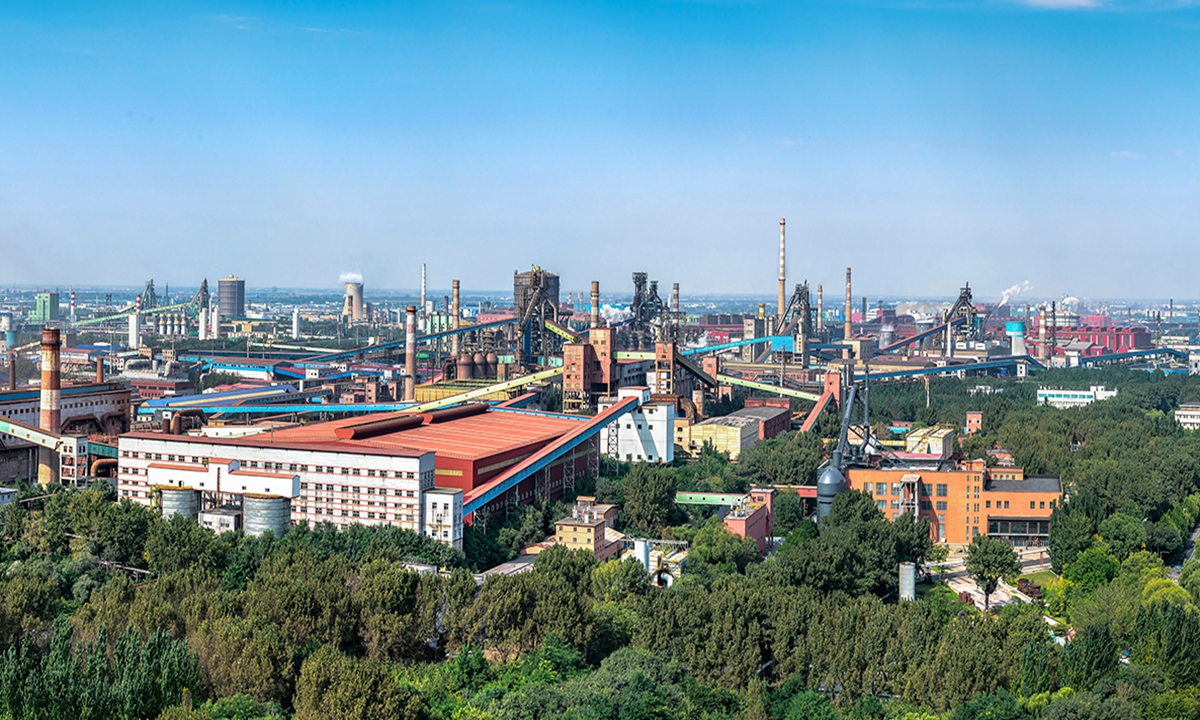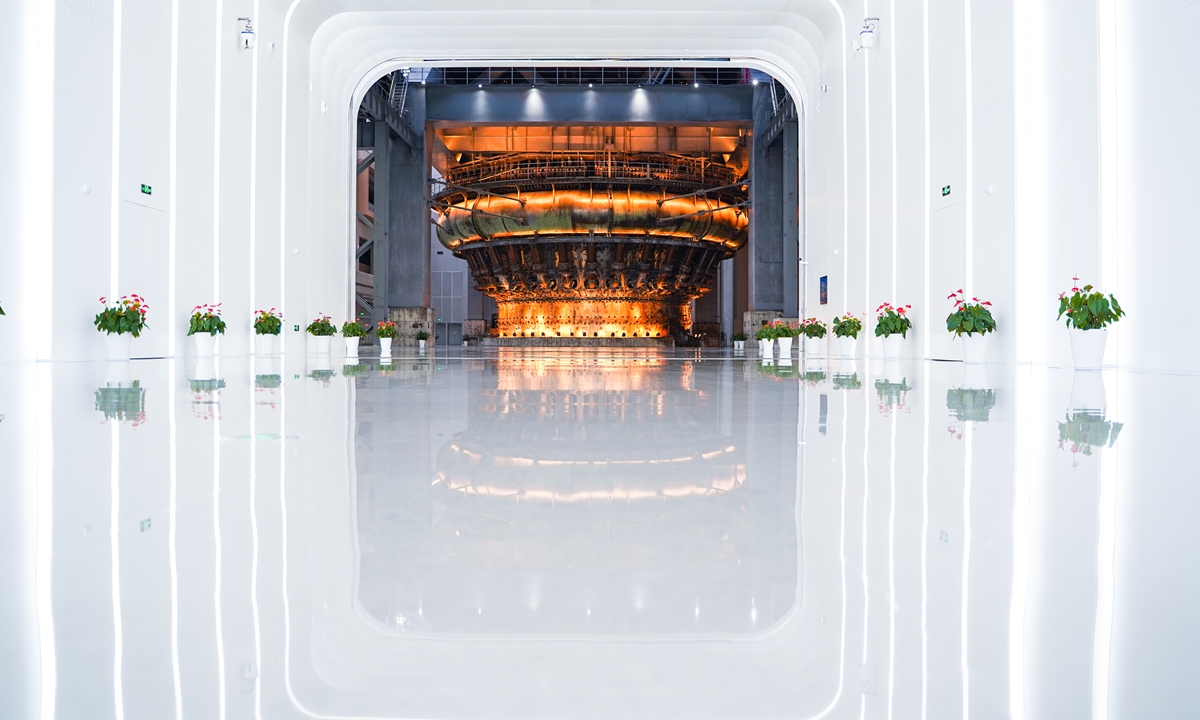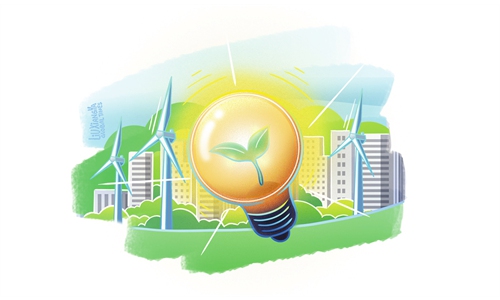IN-DEPTH / IN-DEPTH
China’s steel industry embarks on green shift, battling high carbon emissions through technologies, supportive policies

An aerial view of the Ansteel Group in Anshan, Northeast China’s Liaoning Province.Photos: VCG
Meanwhile, as one of the world's largest producers and consumer of steel, China faces a colossal challenge: Reducing the carbon emission of an industry that is both a cornerstone of its economic might and a significant contributor to global emissions. So how should this be approached, and what progress has been made so far?
During an interview at the Shanghai Climate Week with the Global Times, Jen Carson, global head of industry at the Climate Group, shared her insights on China's green transformation, especially within the steel industry, and the potential for cooperation between China and Europe in the field of low carbon transition.
She highlighted the proactive steps taken by Chinese companies, particularly in the steel industry, toward a green transformation, reflecting a broader commitment to global ecological responsibility.
The Shanghai Climate Week, from April 22 to April 26, is designed to foster social engagement from diverse perspectives in support of China's dual carbon goals. It aims to tell the story of China's actions to address climate change to the world, convey the Asian voice of green transformation, increase international exchanges and cooperation in the field of climate change, and participate in international decision-making and leadership.
Efforts and actions
The ambitious strides taken by industry giants have underscored a significant commitment within China's steel sector, but also reflect a broader narrative of collaboration and sustainability. These efforts are pioneering a shift in the global approach to industrial practices, aiming to integrate deeper environmental responsibility into the core of industrial strategies.
During the interview, Carson recognized the efforts of major Chinese steelmakers which have embarked on remarkable initiatives to reduce their carbon footprints. These companies are not only vocal about their climate ambitions, but have also demonstrated their commitment through strategic partnerships with global automotive leaders.
For example, steel makers such as Baosteel, based in Shanghai, and HBIS, headquartered in Hebei Province, are already showing not only climate ambitions, but also climate commitments by having an MOU with the automotive international stakeholders. Baosteel has a MOU with Beijing Benz Automotive (BBAC) and HBIS has a MOU with BMW Group, Carson explained. "We are very interested to see these developments coming from the Chinese firms."
Further illustrating the impact of corporate concern on environmental sustainability, Carson highlighted the SteelZero initiative, which aims for 100 percent net-zero steel to be used by companies demanding steel by year of 2050. She pointed out the involvement of leading Chinese firms such as CIMC TCREA, one of the world's largest steel container manufacturer, and Hang Lung Properties from the real estate sector. Both companies have made Steel-Zero commitments, showcasing leadership and dedication to sustainable practices in both the shipping marine sector and real estate construction.
Three years ago, China made a solemn commitment to the world that it aims to peak carbon dioxide emissions before 2030 and achieve carbon neutrality before 2060. Since then, the country has embarked on a fast track toward these goals, with highlights in areas including industrial upgrades, cleaner air, renewable energy capacity, and a world-leading position in solar panels, electric cars, and lithium battery production.
Initial results of industrial transformation have been achieved. Official data showed that China's crude steel output has declined by 40 million tons since the start of the 14th Five-Year Plan period (2021-2025), according to the Xinhua News Agency.
China's energy consumption per 10,000 yuan (about $1,408) of gross domestic product decreased by 0.1 percent in 2022 from 2021, while CO2 emissions per 10,000 yuan of GDP fell 0.8 percent year-on-year, according to an official statistical communique.

A steel museum in Wuhan, Central China's Hubei Province Photo: VCG
Bridges and gapsEurope is currently seeking to strengthen its cooperation with China, particularly in the realm of climate policy. Earlier in April, climate envoys from the European Union along with representatives from Germany, France, the Netherlands, and Denmark arrived in Beijing. Their mission is to enhance collaboration with China, aiming to forge stronger ties and joint efforts in addressing global climate challenges, according to reports.
In terms of China-Europe cooperation in the field of low carbon transition, Carson said that she sees many ample opportunities and there are obviously important trading partner relationships and close economic opportunities.
"We are looking forward to seeing more examples of partnerships between specific companies. We are also looking forward to more discussions on international standards," she stated.
Meanwhile, the Climate Group has been instrumental in organizing seminars and discussions aimed at bridging the gap between Chinese and European companies. "This is an area we would like to expand on and develop," she noted.
"Going forward, a key part of our work that we would like to work with others is to bring together and do similar seminars between European and Chinese stakeholders. There is a lot of opportunities across the entire value chain, looking at the demand side as we do, but also steel producers in steel makers and then into the energy infrastructure space," she said.
The organization held a seminar recently with the automotive sector, hosting companies including Volvo Cars, SKF, and also ThyssenKrupp AG, a German steel manufacturer to discuss how they are seeing the transition, playing out from the steel automotive value chain.
During her first visit to Shanghai, Carson expressed her admiration for the city's dynamic approach to sustainable development and urban transformation. "It is clearly the vital city and port, taking a leading stance on sustaining development and urban transformation," she remarked.
She is also keen on learning more about China's dual-carbon development strategies and corporate progress in environmental, social, and governance (ESG) criteria. She anticipates sharing these insights with Europe and other stakeholders to promote the collaboration and exchanges.
Challenges and prospects
China is the world's largest producer and consumer of steel, with steel production accounting for over half of the global share. The carbon emissions from the steel industry account for about 15 percent of the country's total carbon emissions, making it the industry with the largest carbon emissions among the 31 categories of manufacturing industries, according to public data.
As China has promised to peak carbon dioxide emissions by 2030 and achieve carbon neutrality by 2060, the steel industry is making hard efforts in decarbonization, with many challenges to solve.
Carson said that while technologies to decarbonize steel are now available, steelmaking still accounts for around 8 percent of all greenhouse gas emissions.
"With demand for steel increasing as countries develop, the risk is that emissions will only rise further. It's crucial we work together to tackle this challenge," she said.
Carson stressed to the Global Times that the challenge in reducing carbon or achieving carbon neutrality in the steel industry is not just for China, but is a global dilemma.
"It's not just one country-by-country or even one company-by-company. When looking at these unique challenges, China has shown the great willingness to engage the world's largest investor in clean energy," she said.
As the EU's Carbon Border Adjustment Mechanism (CBAM) officially took effect on October 1, 2023, China's steel industry has also faced more external market challenges. The CBAM is to put a fair price on the carbon emitted during the production of carbon intensive goods that are entering the EU, and to encourage cleaner industrial production in non-EU countries. The first batch of industries included in the CBAM are electricity, steel, cement, fertilizers, aluminum, and hydrogen, according to media reports.
According to Carson, currently their members in the initiative "SteelZero," including Chinese companies like CIMC TCREA, a supply chain company affiliated to the China International Marine Containers (CIMC) in the shipping sector, commit to procuring, specifying or stocking 100 percent net zero steel by 2050. Hang Lung Properties in the real estate sector and Volvo Cars in the automotive industry have previously made this commitment.
Industry observers said that the Chinese steel industry is actively responding to the country's commitments to climate change by adopting advanced energy efficiency improvement technologies, steel smelting technologies, and green transformation measures such as waste gas recycling.
At the same time, the industry is optimizing its energy structure to promote sustainable development.
The Chinese government has also introduced policies to support the industry's transformation, including tax incentives and green credit, providing important economic incentives for the industry.
Chinese Premier Li Qiang has signed a decree of the State Council, introducing new regulations governing carbon emissions trading. Effective from May 1, 2024, the regulations aim to provide a legal framework for the operation of China's carbon emissions trading market and ensure the effectiveness of related policies, the Xinhua News Agency reported.
The regulations focus on the allocation of responsibilities, designating the State Council's ecological and environmental departments to oversee and manage carbon emissions trading. The regulations specify details including the products eligible for trading, trading methods, and the distribution of carbon emissions quotas, according to Xinhua.
Carson said that they have already been "impressed" by the Chinese government, in setting out a dual-carbon target and creating a road map.
According to her, an important way to address the challenges is to embrace key stakeholders from different countries across the value chain to undertake candid discussion so as to collectively generate feasible solutions.
"We would love to see that important discussion being developed further. For example, on the relevant standards and verification methods, we can have deeper understanding of the needs that look at the low carbon steel production," she said.
"We would work with the specific companies to understand how they best work with partners in the supply chain or financiers, banks, investors, and different actors to take forward projects that have low carbon technologies and products," she said.
"Steel decarbonization is an incredible challenge, which is why we're working with many stakeholders in the steel value chain… We can only make the best difference if we all move in the same direction. By coming together to share ideas, innovations, and commitments, we empower and challenge each other to take bold action toward a greener, more resilient world," she emphasized.


